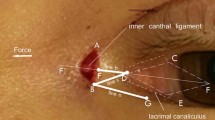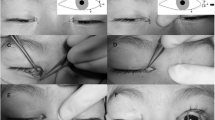Abstract
Purpose
This study aims to investigate the surgical outcomes of a novel epiblepharon correction method based on the pathologic features of epicanthal tissue. The correlation between the pathology and clinical presentations was also studied.
Methods
This retrospective study included 72 eyelids of 36 children with epiblepharon and epicanthal folds. From July 2013 to March 2016, epicanthal tension-releasing procedure of subdermal fibrinolysis with orbicularis oculi ring myotomy were performed in 36 children. Photographs before and after operation were analyzed with Image J program. A clinical severity of the epiblepharon was scored based on the lower eyelid skin fold height (mild to severe). Subdermal fibrosis index was defined as the portion of fibrosis in low power field (× 40) and eyelid contour was assessed with custom software (MATLAB). Eighty eyelids without eyelid pathology were analyzed to establish the normal eyelid contour. The epicanthal tissues were classified into three categories: mild, moderate, and severe fibrosis.
Results
The mean age of the patients was 5.5 years. Intercanthal distance (ICD) ratio was defined as Inner ICD (IICD)/outer ICD (OICD). The IICD/OICD was 0.41 in the severe epiblepharon group that is significantly longer compared to that of the mild epiblepharon group (0.38). Subdermal fibrosis index was higher in severe epiblepharon group. Eyelid contour was normalized and the cilia touch was resolved after the epicanthal tension-releasing procedure.
Conclusion
Epicanthal tension-releasing procedure with orbicularis oculi ring myotomy achieved favorable surgical outcomes. Clinical correlations with pathologic findings and satisfactory results of the procedure suggest that medial epicanthal fibrosis is the main pathologic feature causing epiblepharon and epicanthal folds.





Similar content being viewed by others
References
Johnson CC (1978) Epicanthus and epiblepharon. Arch Ophthalmol 96:1030–1033
Levitt JM (1957) Epiblepharon and congenital entropion. Am J Ophthalmol 44:112–113
Liu D, Hsu WM (1986) Oriental eyelids. Anatomic difference and surgical consideration. Ophthal Plast Reconstr Surg 2:59–64
Jung JH, Kim HK, Choi HY (2011) Epiblepharon correction combined with skin redraping epicanthoplasty in children. J Craniofac Surg 22:1024–1026. https://doi.org/10.1097/SCS.0b013e31821015c8
Kim MS, Sa HS, Lee JY (2014) Surgical correction of epiblepharon using an epicanthal weakening procedure with lash rotating sutures. Br J Ophthalmol 98:120–123. https://doi.org/10.1136/bjophthalmol-2013-303772
Kakizaki H, Ichinose A, Nakano T, Asamoto K, Ikeda H (2012) Anatomy of the epicanthal fold. Plast Reconstr Surg 130:494e–495e. https://doi.org/10.1097/PRS.0b013e31825dc611
Jordan DR, Anderson RL (1989) Epicanthal folds. A deep tissue approach. Arch Ophthalmol 107:1532–1535
Kakizaki H, Leibovitch I, Takahashi Y, Selva D (2009) Eyelash inversion in epiblepharon: is it caused by redundant skin? Clin Ophthalmol 3:247–250
Ni J, Shao C, Wang K, Chen X, Zhou S, Lin H (2017) Modified Hotz procedure combined with modified Z-epicanthoplasty versus modified Hotz procedure alone for epiblepharon repair. Ophthal Plast Reconstr Surg 33:120–123. https://doi.org/10.1097/IOP.0000000000000664
Woo KI, Yi K, Kim YD (2000) Surgical correction for lower lid epiblepharon in Asians. Br J Ophthalmol 84:1407–1410
Park JI (2000) Modified Z-epicanthoplasty in the Asian eyelid. Arch Facial Plast Surg 2:43–47
Khwarg SI, Lee YJ (1997) Epiblepharon of the lower eyelid: classification and association with astigmatism. Korean J Ophthalmol 11:111–117. https://doi.org/10.3341/kjo.1997.11.2.111
Chen CY, Nava-Castaneda A (2013) Successful treatment of lower eyelid epiblepharon by injection of botulinum toxin A in patients under two years of age. Nepal J Ophthalmol 5:177–181. https://doi.org/10.3126/nepjoph.v5i2.8709
Sung Y, Park JS, Lew H (2016) Clinical outcomes of frontalis sling using silicone rod with two-point brow incisions in blepharoptosis. J Pediatr Ophthalmol Strabismus 53:224–232. https://doi.org/10.3928/01913913-20160511-04
Kang D, Lee J, Park J, Lee H, Park M, Baek S (2016) Analysis of lid contour in thyroid eye disease with upper and lower eyelid retraction using multiple radial midpupil lid distances. J Craniofac Surg 27:134–136. https://doi.org/10.1097/SCS.0000000000001995
Milbratz GH, Garcia DM, Guimaraes FC, Cruz AA (2012) Multiple radial midpupil lid distances: a simple method for lid contour analysis. Ophthalmology 119:625–628. https://doi.org/10.1016/j.ophtha.2011.08.039
Ribeiro SF, Milbratz GH, Garcia DM, Fernandes VL, Rocha-Sousa A, Falcao-Reis FM, Cruz AA (2013) Lateral and medial upper eyelid contour abnormalities in graves orbitopathy: the influence of the degree of retraction. Ophthal Plast Reconstr Surg 29:40–43. https://doi.org/10.1097/IOP.0b013e3182747537
Oh J, Lee K (2014) Medial lower lid epiblepharon repair solely by skin-redraping medial epicanthoplasty. Br J Ophthalmol 98:1437–1441. https://doi.org/10.1136/bjophthalmol-2014-304884
Kwon B, Nguyen AH (2015) Reconsideration of the epicanthus: evolution of the eyelid and the devolutional concept of Asian blepharoplasty. Semin Plast Surg 29:171–183. https://doi.org/10.1055/s-0035-1556849
Park JW, Hwang K (2016) Anatomy and histology of an epicanthal fold. J Craniofac Surg 27:1101–1103. https://doi.org/10.1097/SCS.0000000000002628
Acknowledgments
We express sincere gratitude to Hae Youn Kang for pathologic diagnosis and Tae Sun Hwang for providing an anatomical advice.
Author information
Authors and Affiliations
Corresponding author
Ethics declarations
Conflict of interest
The authors declare that they have no conflict of interest.
Ethical approval
All procedures performed in studies involving human participants were in accordance with the ethical standards of the institutional review board and with the 1964 Helsinki declaration and its later amendments or comparable ethical standards. This article does not contain any studies with animals performed by any of the authors.
Informed consent
Informed consent was obtained from all parents of the patients included in the study.
Additional information
Publisher’s note
Springer Nature remains neutral with regard to jurisdictional claims in published maps and institutional affiliations.
Rights and permissions
About this article
Cite this article
Sung, Y., Lew, H. Epiblepharon correction in Korean children based on the epicanthal pathology. Graefes Arch Clin Exp Ophthalmol 257, 821–826 (2019). https://doi.org/10.1007/s00417-019-04271-9
Received:
Revised:
Accepted:
Published:
Issue Date:
DOI: https://doi.org/10.1007/s00417-019-04271-9




